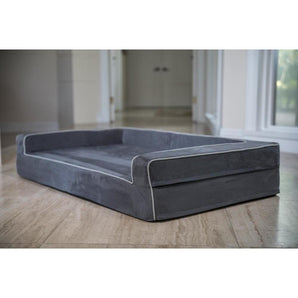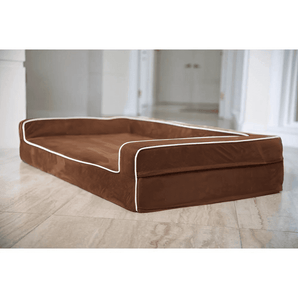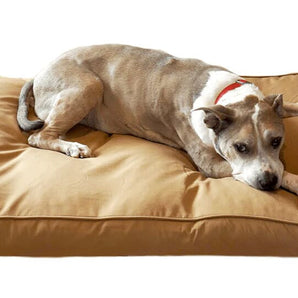If you’re bringing home a new puppy or trying to help your adult dog feel more at ease in your home, crate training can be a total game-changer. When approached correctly, it gives your furry friend a safe, comfortable place to relax while helping with house training, separation anxiety, and even living peacefully with other dogs.
Here are five easy steps for how to crate train a dog:
-
Choose the right crate.
-
Introduce your dog to the crate.
-
Create a positive association with the dog crate.
-
Increase crate time gradually.
-
Transition to more freedom over time.
How to Crate Train a Dog

Crate training is a great way to help your dog feel safe, settled, and confident in your home. Since dogs have a natural instinct to seek out small, cozy spaces—like a den—a crate can become their go-to spot for rest and relaxation. It gives them their own space to unwind, especially helpful when managing multiple dogs or busy households.
1. Choose The Right Crate
Before you dive into crate training, it’s important to start with the right setup. Dogs are den animals by nature, so the crate should feel like a cozy den—safe, secure, and never like a punishment. For large or extra-large breeds, wire crates are a great choice. They’re sturdy, allow plenty of airflow, and give your pup enough space to stretch out without feeling cramped.
As a rule of thumb, your dog should be able to stand up, turn around, and lie down comfortably inside. Too small, and it’ll feel tight and uncomfortable. Too big, and they may be tempted to use one corner as a bathroom. Line the bottom with a durable, chew-proof crate pad or a supportive dog bed that can stand up to drool, digging, and the occasional accident.
Pro Tip: If you have multiple dogs, each pup should have their own space with a separate crate to avoid tension.
2. Introduce Your Dog to the Crate
Start slow and keep it low-pressure. The goal is to help your dog see the crate as a safe, inviting place—not something to be feared. Begin by leaving the crate door open and letting your dog explore on their own terms.
If your pup is unsure, try sitting nearby and speaking calmly in a soothing voice. You can even place treats just outside and eventually just inside the crate to help them build confidence. Toss in a favorite toy, a long-lasting chew, or a piece of clothing that smells like you—anything that helps your dog feel comfortable and encourages that first step inside.
Adult dogs who haven’t been crate trained before may take a little longer to warm up, and that’s totally normal. Be patient and go at their pace. Every positive moment builds toward long-term success.
3. Create a Positive Association With the Dog Crate
This step is absolutely key. You want your dog to want to go into the crate—not because they’re told to, but because it feels like their favorite spot in the house. To do that, focus on building a strong positive association with the crate from the very beginning.
Start by feeding meals inside the crate so your dog links it with something good (food is always a motivator!). Play fun crate games like tossing treats or toys inside and encouraging your pup to go retrieve them. Keep your tone upbeat and make a big deal out of them going in voluntarily.
Once your dog is comfortably walking in and out, begin rewarding calm behavior inside the crate—like sitting, lying down, or just chilling. Close the door for short, stress-free periods while they’re chewing or relaxing, then open it again before they get restless.
4. Increase Crate Time Gradually
Don’t go from 5 minutes to 5 hours. Slowly build up the time your dog spends in the closed crate, starting with a few minutes and working your way up. Stay close at first, then begin stepping out of the room.
If you have other dogs in the house, make sure crate time still feels safe and peaceful. You want your pup to see the crate as a safe space, not as punishment.
5. Transition to More Freedom Over Time
Once your dog is reliably calm and relaxed in their crate, you can start giving them a little more freedom around the house. Keep the crate door open during the day so they can come and go as they please.
Even when they’re fully trained, many dogs will still choose to nap or hang out in their crate. That’s the beauty of honoring your dog’s natural instinct—they want a den-like place to call their own.
When to Use The Crate

Crates can be a lifesaver when used the right way. They help create structure, encourage good behavior, and offer your dog a sense of safety and calm in a busy world. Here are some of the most helpful times to use a crate.
-
For Travel or Vet Visits: A familiar crate with a comfy dog car bed inside can help reduce stress and make the whole experience less overwhelming. Be sure to practice short crate rides at home first so travel doesn't feel like a brand-new (and scary) situation.
-
While House Training a Puppy: Puppies are less likely to go potty where they sleep, so using a crate can teach them to hold it until it's time to go outside. Just remember—young pups have small bladders and can’t hold it for long, so frequent potty breaks are a must.
-
When You're Out of The House: Using the crate while you’re away helps prevent unwanted chewing, potty accidents, and household destruction. Just be sure it’s not all-day, every-day—your pup still needs time to stretch, play, and hang out with you once you're home.
-
For Anxious Dogs: Some dogs feel overwhelmed by too much freedom or stimulation. A crate gives them a calm, consistent place to decompress. Add a chew proof dog bed, cover part of the crate for a den-like feel, and practice rewarding calm behavior when they go inside on their own.
-
When Your Dog Needs a Break: If you have multiple dogs, kids running around, or guests visiting, a crate offers your dog a peaceful spot to chill. Even the most social dogs sometimes need a breather from all the action.
Just remember: it’s not a forever solution for long hours alone. Crate time should be balanced with exercise, play, and socialization.
Common Crate Training Mistakes to Avoid

Crate training can be a smooth experience if you do it correctly, but there are a few common missteps that can slow progress or create bad habits. Here’s what to watch out for:
Using The Crate as Punishment
This is one of the biggest no-nos in dog training. If your dog starts to associate the crate with being in trouble, they’ll naturally avoid it. The crate should always be a safe, cozy space—not the dog version of a time-out. Never send your pup to the crate with frustration in your voice or use it to scold. Instead, focus on rewarding calm behavior and making crate time feel like a reward, not a consequence.
Leaving Them Crated Too Long
Even though dogs are den animals, that doesn’t mean they want to be locked away all day. Long stretches in a closed crate without breaks can lead to boredom, anxiety, or even accidents. Puppies need more frequent potty breaks, and adult dogs still need time to stretch, play, and interact. As a general rule, crate time should be balanced with plenty of exercise, enrichment, and bonding with you.
Skipping The Introduction Phase
We get it—you’re excited to get things rolling. But skipping the slow, step-by-step intro can backfire fast. If you push your dog into the crate and immediately shut the crate door, they might see it as a trap instead of a safe space. Take your time letting them explore with the door closed only when they’re ready, and use treats, praise, and crate games to build that positive association.
Not Being Consistent
Dogs thrive on routine. If crate time is random, rushed, or only happens when you leave the house, it can create stress and confusion. Instead, weave the crate into your daily rhythm—during meals, quiet time, or even naps with the crate door open. Over time, this consistency helps your pup feel at home in their own space.
Reduce Separation Anxiety With Proper Crate Training
If your dog struggles with being left alone, crate training can actually reduce anxiety—when done right. Having a familiar, comfy place of their own can help them self-soothe and feel secure. Toss in a favorite toy, turn on some calming music, and practice short departures.
Remember: rewarding calm behavior, building positive associations, and respecting your dog’s natural instinct to nest can turn crate time into a peaceful, safe experience.





